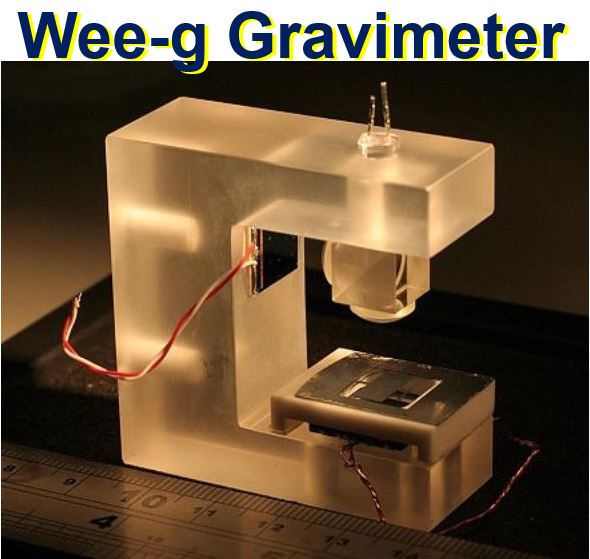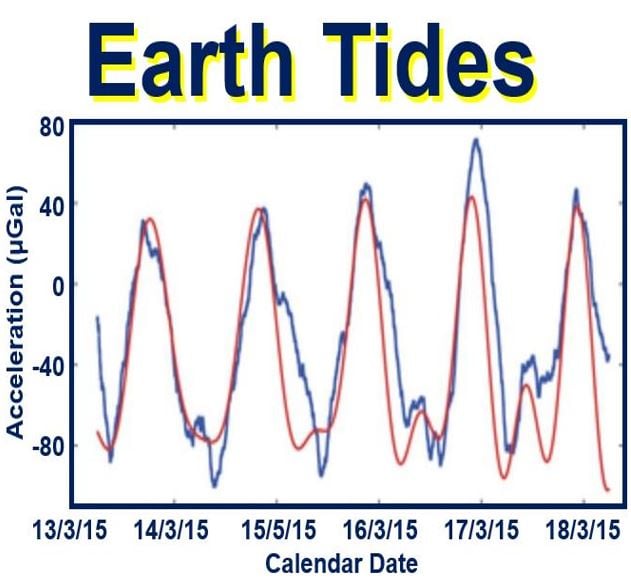By adapting a smartphone system, scientists have managed to make a super sensitive gravity detector – a gravimeter – that can measure tiny changes in gravity and could be used in monitoring volcanoes, oil exploration, environmental surveying, and many other applications.
Scientists from the University of Glasgow wrote about their latest creation in the prestigious journal Nature (citation below).
The gravimeter, built at the University of Glasgow’s James Watt Nanofabrication Centre, is a collaboration between the School of Engineering (Electrical & Nanoscale) and the School of Physics and Astronomy (Institute for Gravitational Research).
 The Wee-g is a relatively small, cheap and ultra-sensitive gravimeter which can detect things under the ground, such as tunnels, landmines, oil & gas deposits, and water or gas pipes. (Image: quantic.ac.uk)
The Wee-g is a relatively small, cheap and ultra-sensitive gravimeter which can detect things under the ground, such as tunnels, landmines, oil & gas deposits, and water or gas pipes. (Image: quantic.ac.uk)
A successful QuantIC outcome
This achievement is one of the first successful research outcomes from QuantIC, Britain’s centre of excellence for research, development and innovation in quantum enhanced imaging, and brings together the Universities of Oxford, Glasgow, Bristol, Strathclyde, Edinburgh, Warwick, and Heriot-Watt “with more than 30 industry partners in a collaborative venture to translate new technological applications and revolutionise imaging across industrial, scientific, security and consumer markets.”
Gravimeters are instruments for measuring the difference in the force of gravity from one place to another – they measure the gravitational field of the Earth.
Although gravimeters have been commercially available for several decades, and are commonly used in the oil & gas industry to find fossil fuel deposits, their very high price and enormous size have limited widespread uptake.
The Wee-g is small, sensitive and cheap
The new ultra-sensitive device – called the Wee-g – uses the same cheap, mass-producible micromechanical systems (MEMS) that are currently used in smartphones’ internal accelerometers.
 The measurements of the Earth tides obtained from the MEMS device. The data has been averaged with a time constant of 240 min. The red line is a mathematical model’s predicion, including an ocean loading correction. The blue line is what the Wee-g recorded. (Image: nature.com)
The measurements of the Earth tides obtained from the MEMS device. The data has been averaged with a time constant of 240 min. The red line is a mathematical model’s predicion, including an ocean loading correction. The blue line is what the Wee-g recorded. (Image: nature.com)
Unlike MEMS telephone technology that uses relatively insensitive and stiff springs to maintain the orientation of the screen relative to Earth, the Wee-g uses a silicon spring which is ten times thinner than an average human hair. This allows the gravimeter’s 12mm-square sensor to detect ultra-tiny changes in gravity.
The researchers used their gravimeter to measure the Earth tides from the basement of the University’s Kelvin building.
Most of us know that the gravitational pull of the Moon affects the tides in our oceans and seas. However, the Moon and the Sun also exert a subtle effect on our planet’s crust – this effect is known as the ‘Earth tides’.
The gravitational pull of the Moon and Sun displace the crust, creating a slight expansion and contraction of the Earth of about 40cm (15.7 inches).
 1. Sheila Rowan. 2. Antonio Samarelli. 3. Giles Hammond. 4. Richard Middlemiss. 5. James Hough. (Images: University of Glasgow)
1. Sheila Rowan. 2. Antonio Samarelli. 3. Giles Hammond. 4. Richard Middlemiss. 5. James Hough. (Images: University of Glasgow)
Wee-g readings aligned with mathematical model predictions
Co-author Dr. Giles Hammond, who works at the University’s School of Physics and Astronomy, said regarding the Earth tides:
“The Earth tides are a well-established phenomenon, which we’re able to accurately predict using mathematical models.”
“One of the factors which separates gravimeters from simple accelerometers is stability, allowing users to monitor variations in gravity over the course of several days-weeks. We used our Wee-g system to monitor the Earth tides under Glasgow over the course of several days, and our results aligned perfectly with the variations in gravity the model had predicted.”
“The significance of this is two-fold: firstly, we’ve shown that a MEMS device can maintain its stability over a long period of time, and secondly, that a device which could easily be built using existing mass-production technology can act as a very accurate gravimeter.”
Co-author Richard Middlemiss, a demonstrator at the School of Physics and astronomy, who believes this economical and lightweight gravimeter will become extremely popular across several industries, said:
“There are a lot of potential industrial applications for gravimeters, but their cost and bulkiness have made them impractical in many situations. Wee-g opens up the possibility of making gravity measurement a much more realistic proposition for all kinds of industries: gravity surveys for geophysical exploration could be carried out with drones instead of planes; and networks of MEMS gravimeters could be places around volcanoes to monitor the intrusion of magma that occurs before an eruption – acting as an early warning system.”
“We’re currently working to make the device smaller and more portable and viaQuantIC we’re building industrial partnerships within several sectors to exploit the device commercially.”
Citation: “Measurement of the Earth tides with a MEMS gravimeter,” A. Samarelli, R. P. Middlemiss, S. Rowan, G. D. Hammond, D. J. Paul & J. Hough. Nature 531, 614–617 (31 March 2016). DOI: 10.1038/nature17397.
Video – Ultra-sensitive gravity sensor
Richard Middlemiss talks about the super-sensitive gravity sensor created at the University of Glasgow. It can detect virtually anything underground, from tunnels to land mines to oil & gas reserves.
